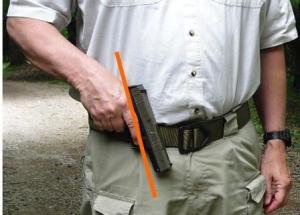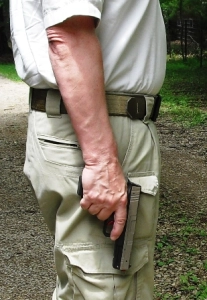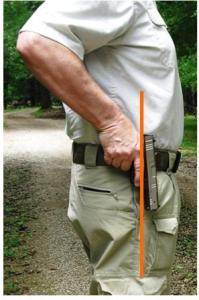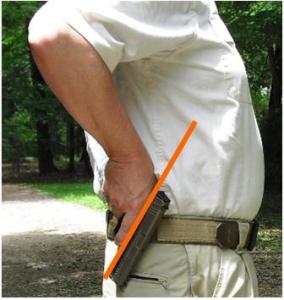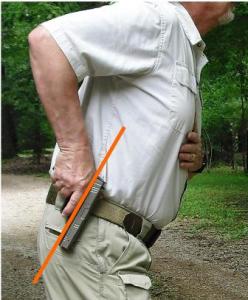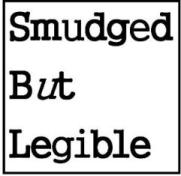Concerning The New TN Permit-less Carry
Posted: April 10, 2021 Filed under: Uncategorized Leave a commentTennessee has become the nineteenth state to adopt what is commonly called permit-less or constitutional carry. Beginning July 1, 2021 (but not before), anyone who would qualify under the current handgun law to obtain an Enhanced Handgun Carry Permit in Tennessee will be able to legally carry a handgun without a permit—both open and concealed carry where now legal to carry.
This new law follows recent, seemingly preparatory changes to Tennessee law that allowed individuals to carry a gun in a vehicle without a permit and created a new permit to carry “concealed only” that can be acquired via an online course (requiring no actual handgun shooting experience).
While giving law-abiding citizens the ability to carry a handgun without the permit process, eliminating both the cost and associated basic firearms training, the law also imposes stiffer penalties for the non-law-abiding who steal a gun or possess it unlawfully.
Permit-less carry does not allow the person the reciprocal privileges of carrying in other states as presently enjoyed by those with the Enhanced Carry Permit. So, if a person intends to carry outside of Tennessee (in accordance with the laws of other states who allow it), the existing permit process will still be the way to go.
The Enhanced Carry Permit option will still be there after July 1 for those who prefer to have a permit. It will still require passing the Tennessee Handgun Safety Course, fingerprints, etc. I assume the new Concealed Carry Permit course will also continue, although, I fail to see a reason for it since it restricts carry to concealed only and the permit-less carry does not.
The understandable controversy around the new law comes from both “sides” of the gun issue. It is no surprise that those opposed to guns in general are against it. But some who support gun rights have concerns as well. Many in law enforcement–being focused on law breakers as they are—reportedly worry about an increase in guns on the street in the wrong (illegal) hands. From a different perspective, some permit holders are concerned that businesses which currently allow people to carry in their establishments (knowing that legal carriers have had at least basic training through the permit process) will now balk at having non-trained gun carriers come in, and will decide to put up the NO GUNS sign in their windows, effectively restricting permit holders’ rights as well.
The term “constitutional carry” obviously refers to our Second Amendment right to keep and bear arms. Some Tennessee lawmakers were not pleased that the new law did not include long guns as well as handguns. That’s right. You will not be allowed to carry around your AR-15 or shotgun “with the intent to go armed” under this new law. While the Second Amendment to the US Constitution does not mention self-defense specifically, the Tennessee Constitution does. This new law is weighted toward that right of common defense. We can hope that it will be applied with an equal weight of common sense. While carrying a handgun may not require a government-issued permit, training in how to safely use that handgun in self-defense should not be considered optional.
As a firearms instructor who has been teaching the carry permit class for years, I have seen well-intentioned, law-abiding students pass the class who really needed more training before actively carrying a gun (The shooting required for the course is very basic and not defensive-carry oriented). How many of those who obtain the permit subsequently carry a handgun? I’ve never seen any statistics, but my impression is the percentage is low, which is fine because at the very least they have acquired a working knowledge of handguns and the law. Will that change now that almost anyone 21 or older will be able to carry a gun? That remains to be seen. The fact that responsible people have an appropriate appreciation of the lethality of a firearm will, I believe, be an incentive for seeking some training and practice with a gun before carrying one. Though shooting a “deadly weapon” is a serious matter, shooting handguns in a safe environment can be quite enjoyable. And training can save your or someone else’s life.
Skills and knowledge you must have if you carry a gun for self-defense:
- Basic firearm safety rules to prevent injury to yourself or others.
- How to safely draw a gun from a holster and put the sights on target in minimal time.
- How to clear a malfunction quickly if the gun won’t fire.
- How to grip a revolver or semi-automatic to prevent injury to your hand when firing.
- Under what circumstances you can legally use a gun (deadly force) in your defense.
To Conceal or Not to Conceal– in Tennessee
Posted: January 1, 2020 Filed under: Uncategorized 2 CommentsThe New Concealed Carry Law in Tennessee is here.
It’s a new year, and Tennessee has a new gun law. You may have read about the changes to the Tennessee Carry Permit laws effective January 1, 2020. Here is how it works:
First of all, current carry permit holders are asking, “How does the change affect me?“ The good news is that it doesn’t. The only change to the law for the existing carry permit process is a name change. To distinguish between the existing permit holders and the “new option” ( more on that later), the State added the word “Enhanced” to the name of the permit. So, if you have a Tennessee Handgun Carry Permit today, it is henceforth and forevermore (until they change it) to be called an Enhanced Handgun Carry Permit. That is the only change.
Why the need for the new nomenclature? That brings me to the new law. Read the rest of this entry »
The High Ready Drill
Posted: March 30, 2017 Filed under: Training Tips, Uncategorized | Tags: handgun training, handguns, personal defense, range Leave a commentIf anyone talks to me for any length of time about shooting, especially self-defense shooting, the subject of practice will likely come up. For many of us, practice options are limited to ranges that require stationary, single-target shots. Some ranges even restrict the rate of fire, precluding multiple-round rapid fire, and forget about being allowed to draw from a holster. So how are we supposed to get realistic practice under these conditions? When I say realistic, I simply mean getting the gun sights on target quickly and firing as soon as they are on target. Here is a simple drill that can be used in almost any range situation.
- Observing all safety rules, take up your shooting stance facing a target three to seven yards away.
- Bring your hands back toward you to the high ready position, where your elbows are bent, yo
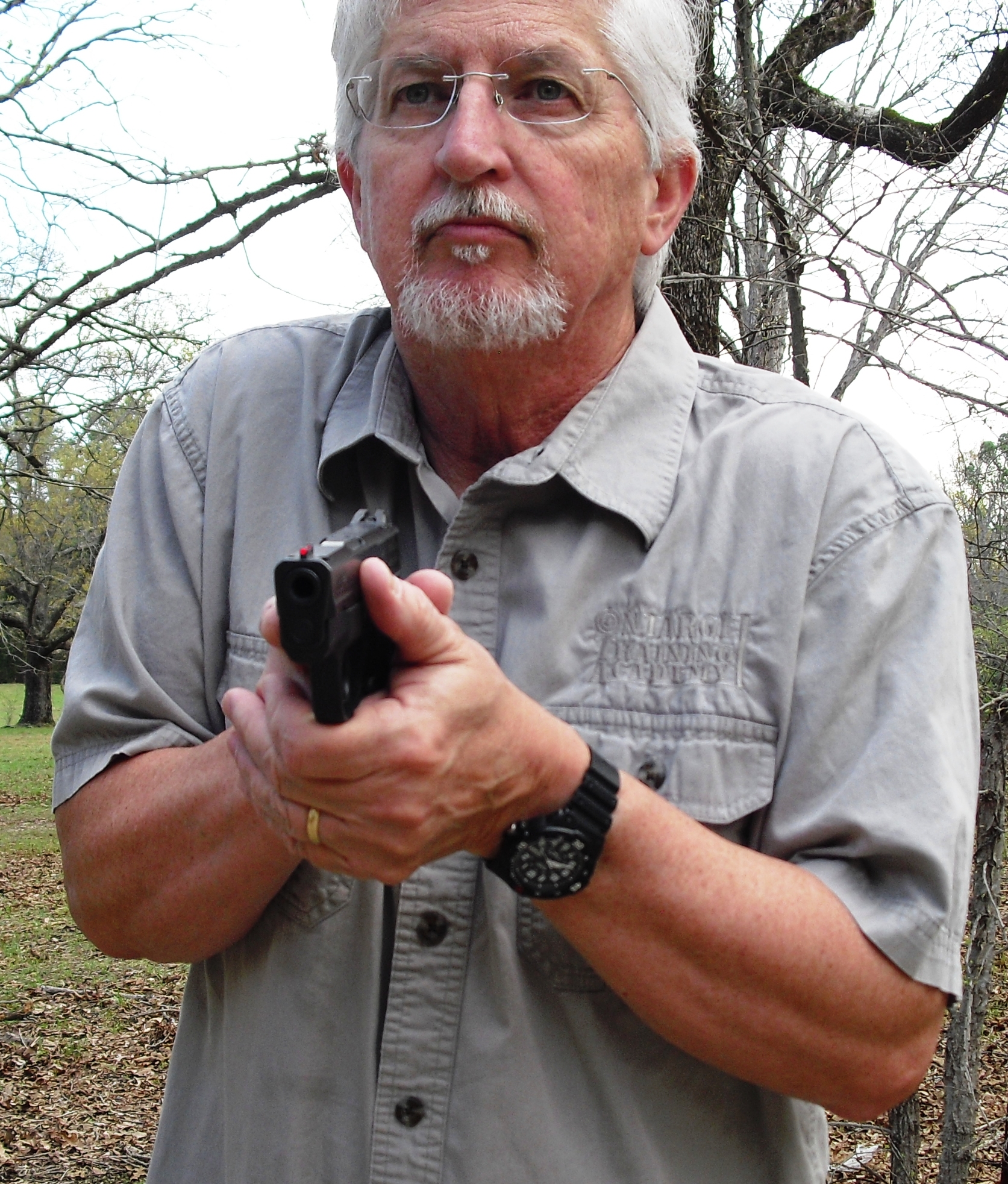 ur upper arms and wrists are close to your torso with the gun about chest high, and the muzzle tilted slightly downward. This is also sometimes called the compressed high ready position.
ur upper arms and wrists are close to your torso with the gun about chest high, and the muzzle tilted slightly downward. This is also sometimes called the compressed high ready position.
- Focus on the target; extend to your shooting position, and shift focus to your front sight. As soon as you are on target, fire (once, twice, or three times if allowed, varying the number each time you extend).
- Remove your finger from the trigger (very important), and come back to high ready.
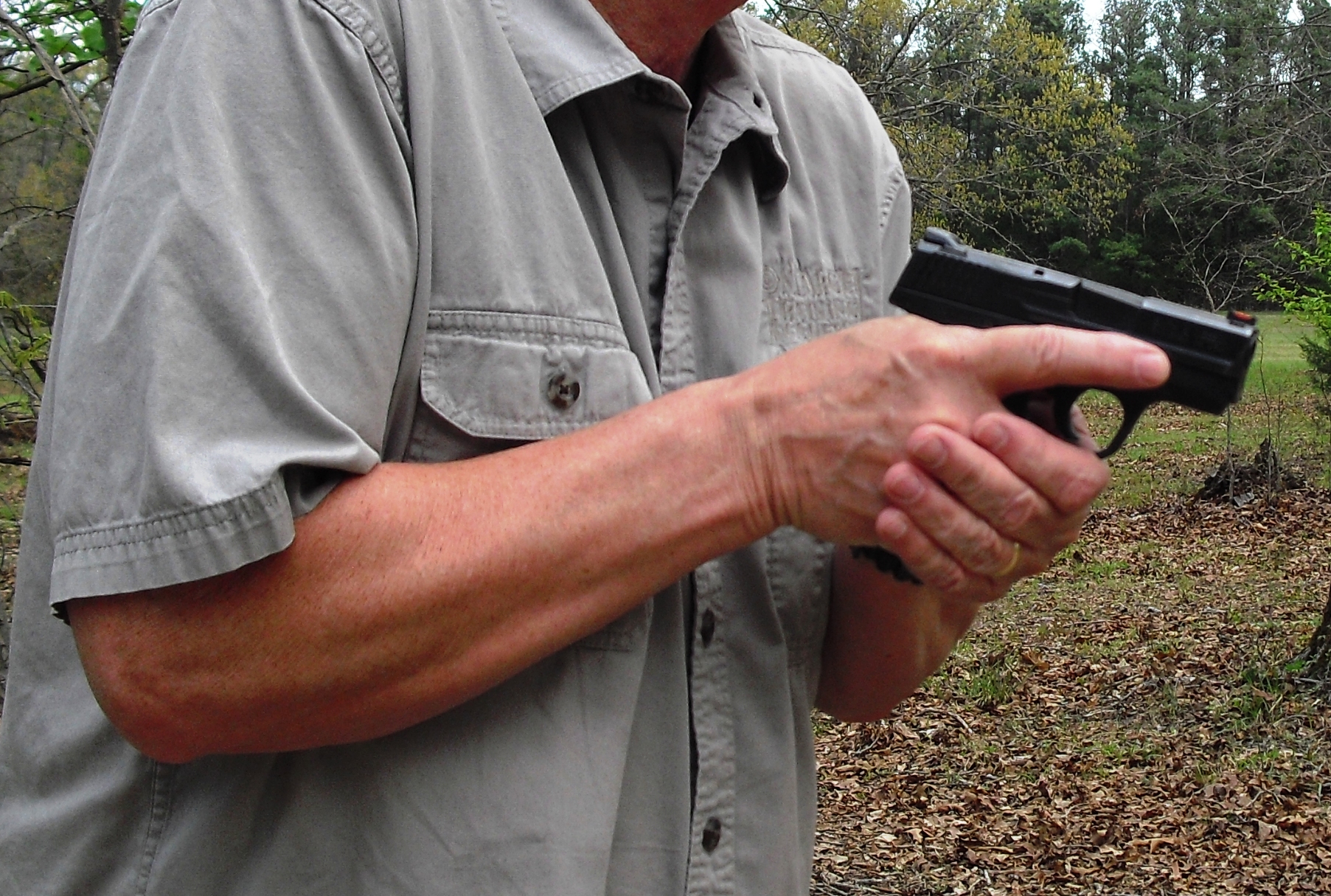
- Repeat the course of fire.
This process gets you pretty close to actual draw and fire action. The high ready position is consistent with how you would present the gun when drawing from a holster just before extension. It is also a reasonable starting position for someone going from room to room in a home. The greatest value here is in learning to get your sights on target as quickly as possible for more realistic defensive shooting practice. It isn’t a race, though. If you are putting rounds more than six inches outside the area of your aim, slow down until you gain accuracy. It isn’t how fast you can pull the trigger, it’s all about developing the hand-eye coordination in bringing your gun up quickly and accurately.
If you have a partner at the range, take turns calling “threat” or “go” for the one who is shooting. This is also a good dry fire drill at home (with absolutely no ammunition in the room). Again, the objective is to get familiar and comfortable with getting your sights on target quickly. In the dry fire situation, you can also start from your holster instead of from the high ready position.
The biggest difference between defensive shooting and target shooting is that in target shooting there is only one target. In defensive shooting, there are two targets—and you are one of them. Whatever threat you might face that puts you in imminent fear of death or serious bodily injury, you are by definition a target. So imagine at the range that the target you are facing can shoot back or attack you with a weapon. Practice accordingly. Be Safe and Ready.
A Holiday Handgun
Posted: December 1, 2016 Filed under: Uncategorized Leave a commentPlanning on getting or giving a handgun for Christmas? Here are two important points to consider to help avoid disappointment after you take your new gun out of the box.
1. Does it fit? – If the gun is for you, be sure to grip it before you buy it. Just because it looks awesome doesn’t mean it is the one for you. The size of your hands and the strength in your hands will determine if a gun will work for you. Your fingers have to be able to manipulate the controls—trigger, slide lock, magazine release (if it is a semi-automatic), and slide. How about the amount of perceived recoil. Can you handle the kick? Your eyes also come in to play. Are the front and rear sights clear to you when you aim? Hopefully, you will be pulling that trigger hundreds of times on the range. A poor fitting gun is no fun after a couple of dozen rounds downrange.
Of course, if you are buying a gun as a gift, I suggest you allow the happy recipient to accompany you to the gun shop—for all the reasons listed above (plus that way you avoid the appearance of a straw purchase, which is a big no no).
2. Does it fit? – No, I didn’t repeat myself. Well, I did, but this “fit” refers to purpose. Does the gun you plan to buy or give fit a purpose? Is the gun to be used for target practice? Is it to be a daily carry gun? Do you intend to mount it on the wall as art work? Okay, not likely the last one, but it is important to evaluate a gun based on its intended use. ‘Carry’ guns tend to be smaller in size and perhaps in caliber than a gun you might plan to stuff under your mattress for home protection (don’t stuff a gun under your mattress, by the way) or one you just want to plink tin cans with. Do they still make tin cans?
Holster Basics
Posted: June 9, 2016 Filed under: Uncategorized | Tags: handgun carry tips, handgun training, personal defense Leave a commentHolsters of one kind or another have been around almost as long as weapons. Scabbards held knifes and swords, quivers held arrows and, inevitably, holsters were developed to hold handguns.
Belts were probably the first handgun holsters of sorts. I can imagine that more than a few pistols ended up clattering to the ground as the wearer bent or twisted in the everyday ambulation of 18th century living. Special scabbards and holsters were developed to hold firearms on saddles, but what about when the rider dismounted? Sash holsters and eventually belt holsters not only kept the handgun handy, they kept it dry and relatively clean—a must for those early guns.
Today, we find a plethora of holster choices for anyone who wishes to carry a handgun. The options can be categorized by type and function. The subject is much too broad to cover in detail here, but we can narrow the options in a general sense. Here are a few: Read the rest of this entry »
TN-Expanding your Castle
Posted: March 5, 2016 Filed under: News | Tags: handgun training, handguns, personal defense 1 CommentTennessee has a bill (House 1748 / Senate 1483) to be heard next week that would allow anyone 21 years or older who is not prohibited by law from possessing a handgun to carry a gun without a permit. This “constitutional carry” type law brings up some interesting questions:
1. If no one would need a permit to carry, why would anyone henceforth bother to get one?
As far as I know, other States would still view my right to carry a gun on their turf as being dependent on their reciprocity laws—accepting a Tennessee permit as valid for their State. If there is no permit, more than likely there would be no right to carry in their State.
Also, a carry permit indicates (to the law enforcement officer, for instance) that the permit holder not only has had at least a minimum of training but has been “backgrounded” and therefore more than likely not a criminal.
2. Since the non-permitted carrier has not had the extensive background check given to those who have gone through the permit process, how does anyone (the law enforcement officer, for instance) know that the gun possessor is not “prohibited by law from possessing a handgun”?
Background checks still occur when a person purchases a handgun. With the current exception of most private, individual sales, everyone who pays retail fills out a Form 4473. While not perfect, that instant background check vets the buyer against the National Instant Criminal Background Check System (NICS) run by the FBI. It is still a viable deterrent to illegal gun purchases.
And do keep in mind, we are only talking about a person being able to carry a gun (open or concealed) outside of their home and car— those places Tennesseans already can possess a gun without permit. So this proposed law is only in effect an extension of the Castle Doctrine to also include the space surrounding the person.
3. Won’t this new law just cause an explosion (no pun intended) in guns out there? Read the rest of this entry »
Seven Tips For the Novice Gun Buyer
Posted: November 17, 2015 Filed under: Uncategorized Leave a commentEverybody has a first time—when it comes to purchasing a handgun. You don’t have to be an expert, but it helps to know a little of the lingo when you walk in to the local gun shop, sporting goods store or pawn shop and begin to peruse the pistols. Here are seven things that will help you handle that conversation across the counter and make your search for the right gun a little easier.
Say what? – First of all, when you tell the salesperson that you want to buy a handgun, don’t be surprised if you get a question like, “What do you want to do with it?” or “How are you going to use it?” Relax. Your Second Amendment rights are not being challenged. It’s an important question. A better phrasing might be, “Do you want the gun for home defense, target practice, daily carry or what?” Why does that matter? Handguns come in a multitude of types, sizes and calibers. Generally speaking, the primary use of the gun dictates the recommended size, caliber and maybe even quality you should consider. For example, if the gun is staying in your house for home defense, you probably want a larger frame and perhaps caliber than you would want if you plan to carry it on your person all day long—although there is no hard, fast rule. For the purpose of this discussion, we will assume that target practice (competitive or otherwise) is not the main reason and will focus on factors common to the other two.
People that sell guns all day long, not unlike subject matter experts in other fields such as auto mechanics or computer technology, may tend to use detailed terminology second nature to them without trying (though some do try) to impress or confuse you. Some terms apply exclusively to semi-automatic pistols or to revolvers, most apply to either. Here are a few that may come in handy:
Get a Grip – Factors in Efficient Holster Draw
Posted: June 28, 2015 Filed under: Uncategorized | Tags: handgun carry tips, handgun training, holster cant, holster draw 2 CommentsHolster Position
Holsters are either concealed or not. If not, they should be worn for ease of access—usually strong side hip. There is usually no need to shift them to the back or to the front.
If concealed, other factors come into play. Often, concealed holsters are worn behind the hip or even in the front (referred to as appendix carry). Regardless of where the holster resides for optimum concealment, the gun needs to be accessible with a relatively natural arm movement to obtain a quick and solid grip. If I have to contort my wrist to get a good grip, my holster is in the wrong place.
In general, the farther to the rear I place my holster, the more forward cant (how much the grip on the pistol is rotated forward or backward) it requires. Cant is often measured in degrees of rotation from perpendicular (muzzle pointed straight at the ground).
A simple experiment of natural cant can be performed by gripping the (preferably empty) gun and holding it at belt level, finger indexed, muzzle straight down. Now start with the gun at the appendix position (to the right of your belt buckle for a righty) as if holstered there. Grip naturally but firmly as if preparing to draw it upward. The natural grip will most likely put the gun in a slightly rearward cant. Now, drop your arm to your side, and then raise it straight up to the belt position again. We’ll call this the 3 o’clock position (with your belt buckle representing 12 o’clock and the small of your back 6 o’clock). Here the grip should be most naturally level, the muzzle and your index finger pointing pretty much straight down. Now slide the gun around toward your back pocket and notice the change in natural cant as you maintain your grip. You may find a mirror helpful at this point. The farther to the rear you position the gun, the more forward cant it requires to maintain a natural grip.
YOU CANT – YES YOU CANT.
Why is that important? When you need to draw—emphasis on need—getting a positive grip and efficient “pull” is critical. If the gun is canted too far forward, your hand and wrist must pivot to an unnatural angle to obtain a good grasp, and the draw also must be at an angle rather than straight up in relation to the grip. While a strong forward cant may improve concealment, it could hinder an efficient draw.
Body position
Now let me mitigate that last statement a little. A second factor that affects holster draw is the angle of your body when you draw. In the previous holster cant experiment I was standing straight. That is the not necessarily the posture a person would assume in a “need-to-draw” situation. I use the term “balance and brace” when teaching shooting stance for draw and fire situations. Balance refers primarily to foot placement. Brace refers to a forward press as if preparing to absorb a frontal assault. That forward press will result in a slight bend at the waist and knees.
If I repeat the cant experiment at the 3 o’clock position in a brace stance, the angle of my body definitely affects the cant, but not as much as it appears since my body (shoulders and arm) also shift forward. My grip angle doesn’t change much, but my body position can accommodate a more aggressive cant than when standing straight up. If you practice a balance-and-brace stance, you may find adding a little cant to the holster assists a natural grip.
In case someone brings it up, I know that many who speed draw for competition actually set up with a rearward cant, which gives the muzzle a head start toward the target when it clears the holster. While that is a variation on the theme, it doesn’t contradict the principle presented here for every day carry since that style of shooting is usually straight up or even leaning back a little as the draw is made.
Whatever your method of drawing your gun–four step or five step draw, etc.–the first motion is to grab the grip high on the back strap. You develop consistency in that motion by repetition, which builds muscle memory. An efficient draw has to start with a positive grip. That comes from practice. A positive grip means your hand has to match up with the pistol or revolver grip. That should be the primary consideration when choosing the position and angle of the holster—unless extreme concealment needs outweigh rapid access needs. And even then, be sure to practice in that position until you are confident that you can get a grip when it counts. Be Safe & Ready.
Dry Fire Practice Target Stands
Posted: May 28, 2015 Filed under: Training Tips | Tags: dry fire practice, handgun training, shooting range, target stands Leave a comment
Training Versus Practice
Posted: May 28, 2015 Filed under: Training Tips | Tags: dry fire practice, handgun training, handguns, range, shooting range Leave a commentAlthough the words have similar meanings, there is a difference between practice and training. For the purpose of gaining an understanding of and proficiency with a handgun for self-defense, we start with training. Training can come from many platforms—a classroom or shooting range, a video on the internet, a book. These all provide information concerning the who, what, when, where and why of handgun use. Training is very important and is the foundation of that other thing—practice.
Practice is the application of what we learn in training. Practice has as its end goal a sense of familiarity and muscle memory, which leads to skill. Practice is important for any discipline: sports, music, art, for instance. What looks so easy for a professional golfer or pianist to do was actually developed through a lot of rigorous practice, honing what was learned in their training.
When we carry a handgun, we carry also a responsibility for its use. To put it plainly, we want to be safe around people and effective in the defense of self and loved ones. Training can teach us how, but it takes practice to get us to the point of effectiveness and keep us there.
Though firing range practice is important, not all relevant practice involves live fire. Here are a few areas we all need to practice on a regular basis:
Draw & Aim—Nothing takes the place of getting comfortable pulling the trigger on live ammunition, learning to handle recoil and getting your sights back on target quickly. But most self defense situations don’t start with the gun aimed at the threat. Training will teach you how to safely draw, extend and aim, but only practice will ensure you can do so effectively when it counts. Draw & Aim practice should be done with no ammunition in the firearm or present in the area even though you will not be pulling the trigger (safety first when practicing). The intent is to develop a skill, muscle memory. Start slowly using good fundamentals. If you don’t know what those fundamentals are, find some training. The bottom line is that if you can’t get your firearm into action quickly and safely in a self-defense situation, the outcome will likely go against you.

